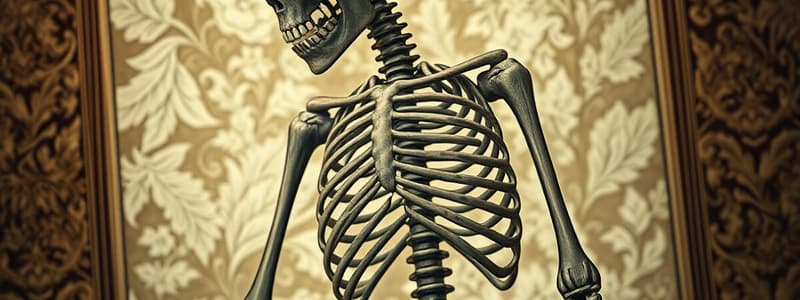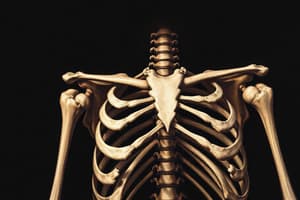Podcast
Questions and Answers
Which of the following is NOT a component of bone as an organ?
Which of the following is NOT a component of bone as an organ?
- Nervous tissue
- Hypertrophic cartilage (correct)
- Adipose tissue
- Epithelial tissue
What is the main function of the skeletal system regarding movement?
What is the main function of the skeletal system regarding movement?
- Stores minerals
- Provides structure for muscles (correct)
- Helps skeletal muscles contract
- Produces red blood cells
What structure connects the diaphysis to the epiphyses in long bones?
What structure connects the diaphysis to the epiphyses in long bones?
- Medullary cavity
- Metaphyses (correct)
- Articular cartilage
- Periosteum
What is the primary molecule that confers hardness to bone tissue?
What is the primary molecule that confers hardness to bone tissue?
Which type of bone cell is responsible for the growth and remodeling of bone?
Which type of bone cell is responsible for the growth and remodeling of bone?
Which of the following best describes the process of calcification in bone tissue?
Which of the following best describes the process of calcification in bone tissue?
What is found within the medullary cavity of long bones?
What is found within the medullary cavity of long bones?
What mineral is NOT typically found in bone extracellular matrix?
What mineral is NOT typically found in bone extracellular matrix?
What role does weight-bearing exercise have on bones?
What role does weight-bearing exercise have on bones?
What percentage of the body’s calcium is stored in bones?
What percentage of the body’s calcium is stored in bones?
Which condition occurs when bones lose density and become brittle?
Which condition occurs when bones lose density and become brittle?
What is the first phase of bone repair after a fracture?
What is the first phase of bone repair after a fracture?
What type of fracture involves broken skin and potentially damage to surrounding tissues?
What type of fracture involves broken skin and potentially damage to surrounding tissues?
What hormone is primarily involved in regulating calcium levels in the blood?
What hormone is primarily involved in regulating calcium levels in the blood?
Which condition results from vitamin D deficiency leading to soft and deforming bones in children?
Which condition results from vitamin D deficiency leading to soft and deforming bones in children?
What is necessary for proper alignment of broken bones during healing?
What is necessary for proper alignment of broken bones during healing?
What complication arises if broken bones do not align properly during healing?
What complication arises if broken bones do not align properly during healing?
Which of these factors significantly affects bone growth?
Which of these factors significantly affects bone growth?
What type of cells do mesenchymal cells differentiate into first during the formation of bone?
What type of cells do mesenchymal cells differentiate into first during the formation of bone?
What is the function of osteoblasts in the formation of bone tissue?
What is the function of osteoblasts in the formation of bone tissue?
Which type of cartilage is formed by chondroblasts during endochondral ossification?
Which type of cartilage is formed by chondroblasts during endochondral ossification?
At what stage does the primary ossification center form in long bones?
At what stage does the primary ossification center form in long bones?
What is formed at the joints during endochondral ossification?
What is formed at the joints during endochondral ossification?
Which zone of the epiphyseal plate anchors it to the bone?
Which zone of the epiphyseal plate anchors it to the bone?
What is the primary role of osteoclasts during bone remodeling?
What is the primary role of osteoclasts during bone remodeling?
What happens to the epiphyseal plate at maturity?
What happens to the epiphyseal plate at maturity?
What is a factor that significantly affects bone growth?
What is a factor that significantly affects bone growth?
What occurs during appositional growth of bone?
What occurs during appositional growth of bone?
What occurs during interstitial growth of bone?
What occurs during interstitial growth of bone?
Which hormone is known to inhibit bone resorption by promoting apoptosis of osteoclasts?
Which hormone is known to inhibit bone resorption by promoting apoptosis of osteoclasts?
What is the primary purpose of bone remodeling?
What is the primary purpose of bone remodeling?
What is the primary function of osteoblasts?
What is the primary function of osteoblasts?
What happens to osteoblasts once they are immobilized by their own secretions?
What happens to osteoblasts once they are immobilized by their own secretions?
Which of the following is a key function of osteocytes?
Which of the following is a key function of osteocytes?
What process is performed by osteoclasts in bone tissue?
What process is performed by osteoclasts in bone tissue?
Which type of bone tissue is characterized as the strongest?
Which type of bone tissue is characterized as the strongest?
What is the structural unit of compact bone called?
What is the structural unit of compact bone called?
What are canaliculi primarily used for?
What are canaliculi primarily used for?
Where is red bone marrow found?
Where is red bone marrow found?
What is one function of the periosteal arteries?
What is one function of the periosteal arteries?
Which phase of life does not require bone formation?
Which phase of life does not require bone formation?
What is the process of bone formation called?
What is the process of bone formation called?
What type of ossification occurs directly from mesenchymal tissue?
What type of ossification occurs directly from mesenchymal tissue?
What do trabeculae in spongy bone tissue provide?
What do trabeculae in spongy bone tissue provide?
The term 'vascularization' in bone refers to what?
The term 'vascularization' in bone refers to what?
Flashcards are hidden until you start studying
Study Notes
Bone Structure and Composition
- Bone is an organ composed of osseous tissue, cartilage, dense connective tissue, epithelial tissue, adipose tissue, and nervous tissue.
- The study of bone structure is called osteology.
- The skeletal system performs six main functions:
- Provides support for muscles and other tissues.
- Protects internal organs.
- Assists movement when skeletal muscles contract to move bones.
- Assists mineral homeostasis by providing a source of calcium and phosphorus.
- Specific bones are the site of red blood cell production.
- Other bones contain yellow bone marrow that stores triglycerides.
- Long bones consist of:
- Diaphysis or bone shaft.
- Epiphyses, the knobby ends of bones.
- Metaphyses, connecting the diaphysis to the epiphyses.
- Articular cartilage, reducing friction between bones at joints.
- Periosteum, the outer covering of bones where tendons and ligaments attach.
- Medullary cavity, the hollow part of the diaphysis containing yellow bone marrow and blood vessels.
- Endosteum, a membrane lining the medullary cavity composed of a single layer of osteocytes and a thin layer of connective tissue.
- Bone tissue is a connective tissue consisting of cells sparsely distributed in a hard ECM.
- The ECM of bone is composed of water (15%), collagen fibers (30%), and mineral salts (55%).
- Mineral salts deposit on a network of collagen fibers, hardening the bone.
- The mineral salts provide hardness and the collagen fibers provide tensile strength.
- This process is called calcification.
- The mineral salts of bone ECM include:
- Hydroxyapatite - Ca10(PO4)6(OH)2
- Calcium phosphate - Ca3(PO4)2
- Calcium hydroxide - Ca(OH)2
- Calcium carbonate - CaCO3
- Bone cells contribute to bone formation, growth, and remodeling:
- Osteoprogenitor cells are stem cells of bone, located deep to the periosteum.
- Osteoblasts secrete collagen and other components of bone ECM, do not divide, and become osteocytes once immobilized.
- Osteocytes are mature bone cells that do not divide or secrete but acquire nutrients and eliminate wastes.
- Osteoclasts catabolize bone, formed by fusion of monocytes, and secrete lysosomal enzymes and acids for bone resorption, releasing minerals into the blood.
Bone Tissue Types
- Two types of bone tissue exist: spongy bone tissue and compact bone tissue.
- Compact bone is the strongest of the bone tissues, resistant to mechanical stress, and densely packed.
- The structural unit of compact bone is the osteon, which is arranged along lines of stress.
- The osteonic canal contains blood vessels supplying nutrients and hormones.
- Concentric lamellae are surrounding rings of ECM.
- Interstitial lamellae are remnants of old concentric lamellae from old osteons found between existing osteons.
- Circumferential lamellae surround the long bone (along the circumference) and are joined to the periosteum via perforating fibers.
- Osteocytes occupy spaces in the ECM called lacunae.
- Canaliculi permit communication between osteocytes, filled with extracellular fluid, and osteocytes project into canaliculi for nutrient uptake and waste excretion.
- Interosteonic canals provide passage for blood vessels and nerves, penetrating bone from the periosteum into the medullary cavity.
- Extensive vascularization contributes to the rapid healing of bone tissue.
- Spongy bone tissue is not composed of osteons.
- The structural unit of spongy bone is the trabeculae, plates or projections of bone tissue arranged along areas of stress.
- Red bone marrow and blood vessels surround the trabeculae.
- Red bone marrow contains blood stem cells.
- Spongy bone is lighter than compact bone, filling bones to make them easier for muscles to move.
- Spongy bone supports and protects bone marrow.
- Spongy bone tissue handles stress along multiple axes better than compact bone tissue.
Nerve and Blood Supply of Bone
- Bone is well vascularized.
- Periosteal arteries nourish the periosteum.
- Nutrient arteries penetrate the diaphysis and branch into bone marrow, entering through the nutrient foramen.
- Epiphyseal and metaphyseal arteries nourish the internal tissues of the epiphyses, branching from the nutrient artery.
- All veins exit via the same entrance as the cognate arteries; e.g., the nutrient vein exits via the nutrient foramen.
- Nerves run similar paths to blood vessels through bones.
- The blood supply of bone performs several functions:
- Nutrient delivery: Supplies essential nutrients and oxygen to bone cells.
- Waste removal: Helps remove metabolic waste products from bone tissue.
- Bone remodeling: Delivers cells involved in bone formation and resorption.
- Hormone transport: Transports hormones regulating bone metabolism.
- Immune function: Facilitates movement of immune cells.
- The nerve supply of bone performs several functions:
- Pain perception: Detects pain, signaling injury or disease.
- Regulation of bone metabolism: Influences bone remodeling by affecting osteoblast and osteoclast activity.
- Response to mechanical stimuli: Senses mechanical stress on bones and influences bone adaptation and remodeling.
- Vascular regulation: Influences blood flow to bone for nutrient delivery.
- Communication with other systems: Coordinates bone function with overall homeostasis.
Ossification
- Bone formation is called ossification.
- Ossification occurs during four major life phases:
- Development of the embryonic skeleton.
- Development during childhood and adolescence.
- During bone remodeling.
- During the repair of fractures.
- The embryonic skeleton is initially composed of mesenchymal tissue.
- Two general patterns of ossification exist:
- Intramembranous ossification: Bone develops directly from mesenchymal tissue.
- Endochondral ossification: Bone develops from a hyaline cartilage intermediate.
- Intramembranous ossification hardens the embryonic cranium and facial bones.
- Intramembranous ossification proceeds in four steps:
- Formation of the ossification center: Mesenchymal cells transform into osteoprogenitor cells and then osteoblasts, secreting bone ECM.
- Calcification of mineral salts secreted by osteoblasts occurs.
- Formation of trabeculae in spongy bone tissue: Connective tissue between trabeculae becomes red bone marrow.
- Formation of the periosteum: Mesenchymal tissue surrounding forming trabeculae compacts and hardens into the periosteum.
- Key points about intramembranous ossification:
- Bone forms directly from mesenchymal tissue.
- Produces both spongy and compact bone tissue.
- Begins in the embryo.
- Forms flat cranial and most facial bones.
- Endochondral ossification forms most bones, including long bones.
- Endochondral ossification proceeds in six general steps:
- Mesenchymal cells differentiate into chondroblasts, secreting collagen and forming hyaline cartilage as the future diaphysis.
- Chondroblasts secrete ECM, resulting in interstitial growth and mature chondrocytes dying to become lacunae.
- Penetration of a nutrient artery through the perichondrium stimulates osteoprogenitor cells to mature into osteoblasts, forming trabeculae in the growing diaphysis, hardening the perichondrium into periosteum, and causing hyaline cartilage disintegration due to lack of nutrients.
- Primary ossification extends toward the ends of bones, and osteoclasts digest some spongy bone to form the medullary cavity.
- Secondary ossification center forms at birth and continues throughout adolescence.
- Hyaline cartilage at joints becomes articular cartilage, and remaining cartilage at the metaphysis ossifies during adolescence.
Bone Growth During Childhood and Adolescence
- Bones can grow interstitially or appositionally.
- Interstitial growth occurs lengthwise at the epiphyseal plate of long bones and can be subdivided into four zones:
- Zone of resting cartilage: Anchors the epiphyseal plate to bone and does not divide.
- Zone of proliferating cartilage: Contains actively dividing chondrocytes that contribute to interstitial growth.
- Zone of hypertrophic cartilage: Contains mature chondrocytes, large cells arranged in columns.
- Zone of calcified cartilage: Contains layers of dead chondrocytes that can be cleared by osteoclasts during bone remodeling; becomes "new diaphysis."
- At maturity, the epiphyseal plate closes:
- Chondrocytes cease to divide, and ECM calcifies.
- Occurs around 18 years in females and 21 years in males.
- The remaining mark is called the epiphyseal line.
- Appositional growth is circumferential growth and proceeds in four steps:
- Periosteal cells become osteoblasts, forming ridges of ECM around periosteal vessels.
- Ridges fuse, and the former periosteum becomes the endosteum.
- Endosteal osteoblasts secrete ECM, forming new concentric lamellae.
- New concentric lamellae increase the diameter of the bone.
- Osteoclasts in the endosteum catabolize bone, enlarging the medullary cavity.
- Factors affecting bone growth include:
- Nutrition: Adequate calcium, phosphate, vitamin D, and other nutrients are essential.
- Hormones: Growth factors, thyroid hormones (T3 and T4), estrogen, and testosterone influence bone growth.
- Exercise: Mechanical stress from weight-bearing exercises stimulates bone remodeling.
Bone Remodeling
- A dynamic, lifelong process where 5% of bone is remodeled at any given time.
- Bone resorption is the destruction of the ECM, and bone deposition is the building of new ECM.
- Bone remodeling encompasses both bone resorption and deposition.
- Bone is remodeled during growth, during and after injury, and with changes in exercise and diet.
- During remodeling, osteoclasts attach to bone, enzymes and acids catabolize bone, and minerals are released into the blood through transcytoses.
- Osteoblasts deposit bone along lines of mechanical stress (e.g., the distal portion of the femur is remodeled every 4 months).
- Exercise affects bone remodeling:
- Weight-bearing exercise stimulates bone remodeling due to skeletal muscle pulling on bones and gravity pulling on bones.
- A sedentary lifestyle or injury leads to bone loss, shifting the balance towards resorption.
- Bone remodeling plays a vital role in calcium homeostasis.
- Bone stores 99% of the body's calcium, which is involved in several bodily functions:
- Nerve and muscle cell function.
- Blood clotting.
- Enzyme catalysis as a cofactor.
- Plasma calcium levels are tightly regulated (9-11 mg/100 mL).
- Low levels can lead to heart and respiratory dysfunction.
- The parathyroid gland regulates blood calcium levels:
- Low calcium levels stimulate parathyroid hormone production, which promotes bone resorption by osteoclasts, increases calcium retention by the kidneys, and stimulates calcitriol synthesis, ultimately increasing blood calcium levels.
- This is a negative feedback loop.
Fractures and Bone Repair
- Fractures are breaks in bones.
- Microscopic fractures without surrounding tissue damage are called stress fractures.
- Large fractures with damage to surrounding tissues are called compound fractures.
- Causes include:
- Trauma.
- Repeated stressful or vigorous activities.
- Disease.
- Treatment of fractures involves reduction, aligning the broken ends of bones to initiate healing:
- Closed reductions occur without surgery, "setting" the bones.
- Open reductions occur with surgery, where skin is broken, bones are realigned, and fixed with screws, plates, etc.
- Splints, casts, and immobilization aid in healing.
- Proper alignment of broken ends is crucial to prevent malunion, a healed bone deformity.
- Bone repair proceeds in three phases:
- Reactive phase: Fracture hematoma formation (clot-like structure), inflammation, and immune cell recruitment.
- Reparative phase: Fibrocartilaginous callus formation, a soft collagen bridge between fractured ends.
- Bone remodeling phase: Osteoclasts remove dead bone, and compact bone replaces spongy bone tissue around the fracture, thickening at the former fracture site.
- A bone healed from a compound fracture may potentially be stronger than a bone that has never been broken due to adaptation processes.
Bone Disorders
- Osteoporosis is a loss of bone density:
- Higher levels of bone resorption than bone deposition.
- Increases fracture risk.
- Disproportionately affects elderly women, possibly due to estrogen inhibition of osteoblast activity.
- Treatment includes:
- Diet rich in calcium.
- Weight-bearing and resistance exercises.
- Medication.
- Rickets and osteomalacia are different manifestations of the same disease, vitamin D deficiency:
- Rickets is a childhood disease:
- Low vitamin D levels lead to inefficient calcium absorption.
- Bones soften and deform, leading to "bow legs."
- Osteomalacia is the same disease in adults.
- Rickets is a childhood disease:
Studying That Suits You
Use AI to generate personalized quizzes and flashcards to suit your learning preferences.




